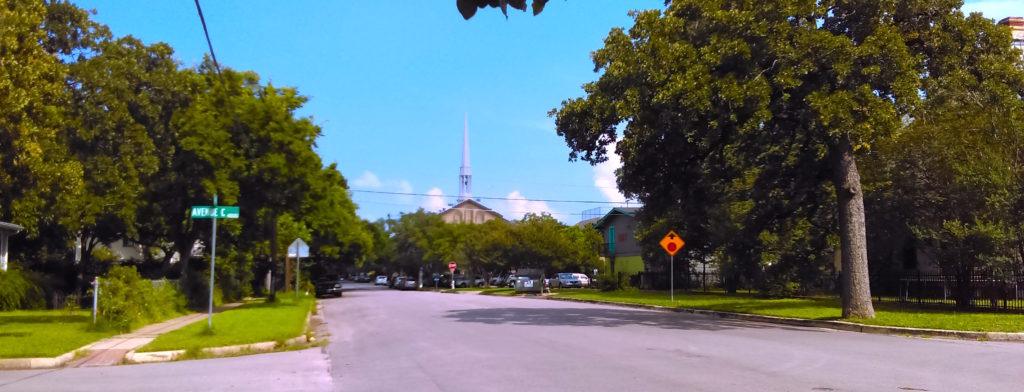
Commentary on Proust – No. 3
It was the steeple of Saint-Hilaire which shaped and crowned and consecrated every occupation, every hour of the day, every point of view in the town. From my bedroom window I could discern no more than its base, which had been freshly covered with slates; but when on Sundays I saw these, in the hot light of a summer morning, blaze like a black sun I would say to myself: “Good heavens! nine o’clock! I must get ready for mass at once if I am to have time to go in and kiss aunt Léonie first,” and I would know exactly what was the colour of the sunlight upon the Square, I could feel the heat and dust of the market, the shade behind the blinds of the shop into which Mamma would perhaps go on her way to mass, penetrating its odour of unbleached calico, to purchase a handkerchief or something, of which the draper himself would let her see what he had, bowing from the waist: who, having made everything ready for shutting up, had just gone into the back shop to put on his Sunday coat and to wash his hands, which it was his habit, every few minutes and even on the saddest occasions, to rub one against the other with an air of enterprise, cunning, and success.
And again, after mass, when we looked in to tell Théodore to bring a larger loaf than usual because our cousins had taken advantage of the fine weather to come over from Thiberzy for luncheon, we had in front of us the steeple, which, baked and brown itself like a larger loaf still of ‘holy bread,’ with flakes and sticky drops on it of sunlight, pricked its sharp point into the blue sky. And in the evening, as I came in from my walk and thought of the approaching moment when I must say good night to my mother and see her no more, the steeple was by contrast so kindly, there at the close of day, that I would imagine it as being laid, like a brown velvet cushion, against—as being thrust into the pallid sky which had yielded beneath its pressure, had sunk slightly so as to make room for it, and had correspondingly risen on either side; while the cries of the birds wheeling to and fro about it seemed to intensify its silence, to elongate its spire still further, and to invest it with some quality beyond the power of words.
Even when our errands lay in places behind the church, from which it could not be seen, the view seemed always to have been composed with reference to the steeple, which would stand up, now here, now there, among the houses, and was perhaps even more affecting when it appeared thus without the church. And, indeed, there are many others which look best when seen in this way, and I can call to mind vignettes of housetops with surmounting steeples in quite another category of art than those formed by the dreary streets of Combray. I shall never forget, in a quaint Norman town not far from Balbec, two charming eighteenth-century houses, dear to me and venerable for many reasons, between which, when one looks up at them from a fine garden which descends in terraces to the river, the gothic spire of a church (itself hidden by the houses) soars into the sky with the effect of crowning and completing their fronts, but in a material so different, so precious, so beringed, so rosy, so polished, that it is at once seen to be no more a part of them than would be a part of two pretty pebbles lying side by side, between which it had been washed on the beach, the purple, crinkled spire of some sea-shell spun out into a turret and gay with glossy colour. Even in Paris, in one of the ugliest parts of the town, I know a window from which one can see across a first, a second, and even a third layer of jumbled roofs, street beyond street, a violet bell, sometimes ruddy, sometimes too, in the finest ‘prints’ which the atmosphere makes of it, of an ashy solution of black; which is, in fact, nothing else than the dome of Saint-Augustin, and which imparts to this view of Paris the character of some of the Piranesi views of Rome.
–Proust, “Combray”[1]
When I first read this passage from Proust, early in the “Combray” section, about the steeple to the church in Combray, I was immediately reminded of two things:
(1) The steeple to Hyde Park Baptist Church in Austin, Texas (off of Speedway, not far from the Jason’s Deli on Red River):
And (2) this scene of a church from The Omen (1976):
NOTES
![]()
[1] Proust, Marcel. À la recherche du temps perdu. (In Search of Lost Time.) Vol. I. Du côté de chez Swann. (Swann’s Way.) Translated by Charles Kenneth Scott Moncrieff and Terrence Kilmartin. § “Combray.â€


0 comments ↓
There are no comments yet...Kick things off by filling out the form below.
Leave a Comment